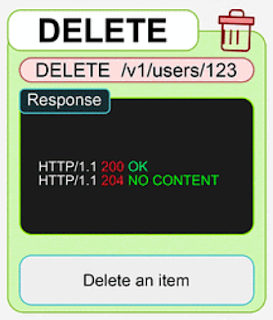HTTP (Hypertext Transfer Protocol) defines several request methods, also known as HTTP verbs, that indicate the desired action to be performed on a resource.
 |
| HTTP - Hypertext Transfer Protocol |
Here are the top HTTP request methods:
1. GET:
- Used to retrieve data from a specified resource.
- Requests should have no side effects on the server.
 |
| GET METHOD |
2. POST:
- Used to submit data to be processed to a specified resource.
- Often used when uploading a file or submitting a form.
 |
| POST Method |
3. PUT:
- Used to update a resource or create a new resource if it does not exist.
- Replace the entire resource with the provided data.
 |
| PUT Method |
4. DELETE:
- Used to request the removal of a resource.
- It should be used cautiously, as it deletes the specified resource.
 |
| DELETE Method |
5. PATCH:
- Used to apply partial modifications to a resource.
- It is typically used for updating a resource with only the changes provided.
 |
| PATCH Method |
6. HEAD:
- Similar to GET but does not return the actual data, only the headers.
- Useful for checking if a resource has been modified without retrieving the entire content.
 |
| HEAD Method |
7. OPTIONS:
- Used to describe the communication options for the target resource.
- It allows the client to determine the available methods or requirements.
 |
| OPTIONS Method |
8. TRACE:
- Used for diagnostic purposes to retrieve the contents of the target resource's message as it passes along the path to the destination.
 |
| TRACE Method |
9. CONNECT:
- Reserved for use with proxy servers.
- It establishes a tunnel to the server identified by a given URI.
 |
| CONNECT Method |
These HTTP methods provide a standardized way for clients to interact with web servers and perform various actions on resources. The choice of method depends on the desired operation and the semantics of the action being performed.

